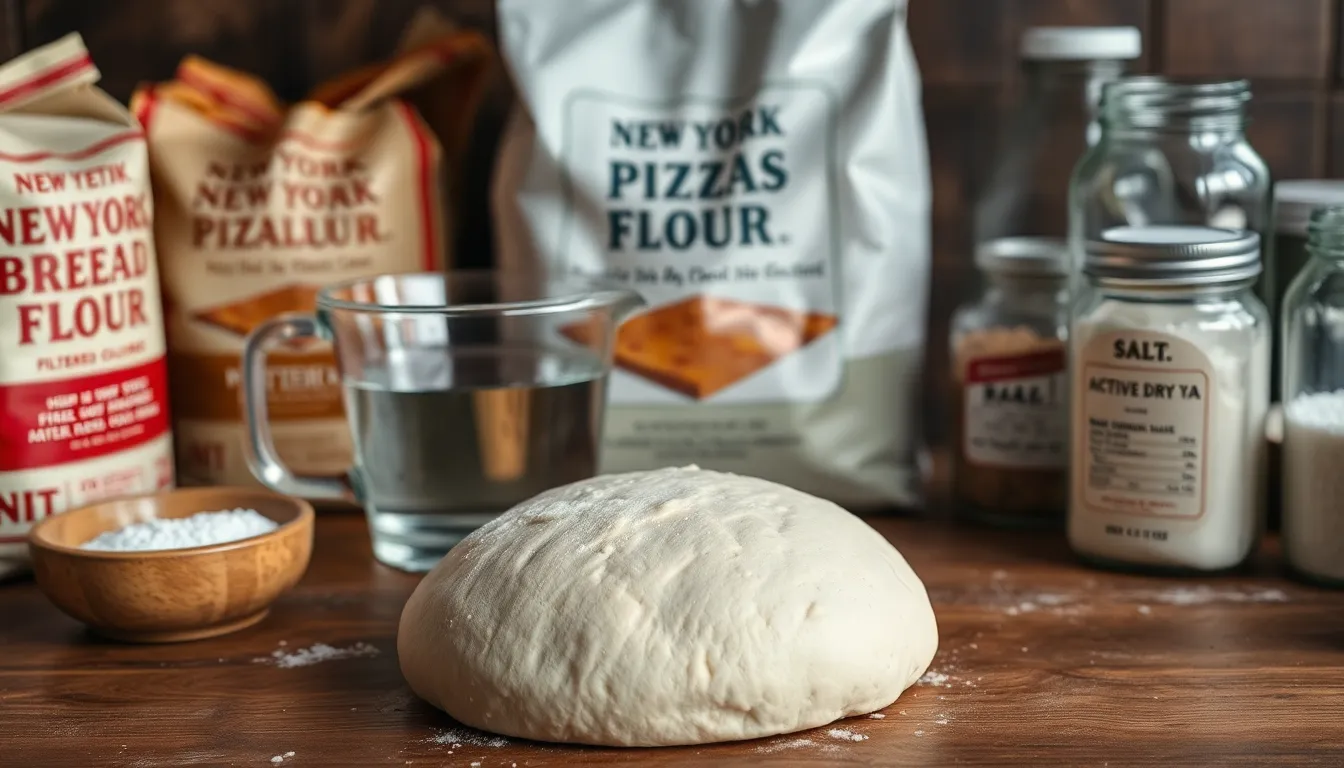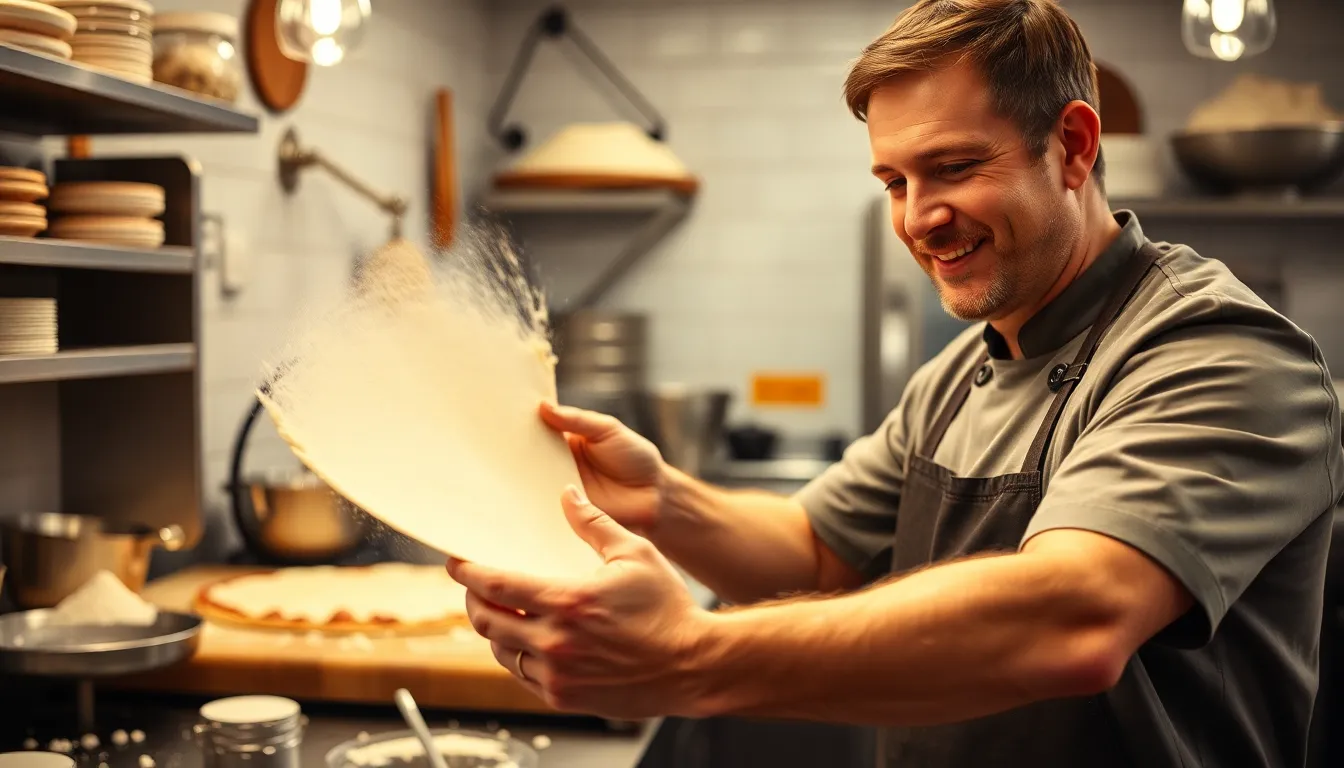Table of Contents
ToggleNew York style pizza dough is the unsung hero behind the iconic slice that has captured the hearts of pizza lovers everywhere. Known for its thin yet chewy crust, this dough strikes the perfect balance between crispy and soft, making it ideal for folding and savoring.
Creating the perfect New York style pizza dough requires a blend of quality ingredients and precise techniques. From the right flour to the ideal fermentation time, each step plays a crucial role in achieving that signature flavor and texture. Whether you’re a seasoned chef or a home cook, mastering this dough can elevate your pizza game to new heights.
Overview of New York Style Pizza Dough
New York style pizza dough features a unique blend of characteristics that set it apart from other pizza styles. This dough achieves a thin, chewy crust that combines both crispiness and softness, creating an ideal base for various toppings. Quality ingredients play a crucial role, with high-protein bread flour often preferred for its gluten content, which contributes to the dough’s structure.
Fermentation time determines the dough’s flavor and texture. A longer fermentation, typically 24 to 72 hours, enhances the dough’s taste and creates a complex flavor profile. Successful pizza makers monitor hydration levels, aiming for a dough consistency that maintains elasticity but remains manageable.
Specific techniques ensure the dough is adequately kneaded and shaped, allowing it to stretch easily without tearing. Using a pizza stone or steel for baking can replicate the high heat of traditional pizza ovens, helping achieve a well-cooked crust with desirable characteristics. Mastering New York style pizza dough allows chefs and home cooks to elevate their pizza creations, making it a cornerstone of authentic pizzeria experiences.
Key Ingredients

The foundation of New York style pizza dough lies in its key ingredients. Each element plays a vital role in achieving the perfect balance of flavor and texture.
Flour Types
Flour selection significantly impacts dough quality. High-protein bread flour is commonly used for its strong gluten structure, providing the necessary elasticity and chewiness. Combining all-purpose flour with bread flour can create a lighter crust while maintaining a good chew. Specialty flours, such as “00” flour, offer fine texture and strong gluten, enhancing the overall pizza experience.
Water Quality
Water quality affects dough hydration and yeast activation. Using filtered water improves taste and prevents impurities from altering flavors. The ideal water temperature ranges from 60°F to 70°F, ensuring optimal yeast activity during fermentation. Too hot water can kill yeast, while too cold can slow down the fermentation process, hindering dough development.
Yeast Selection
Yeast plays a crucial role in fermentation and leavening. Active dry yeast and instant yeast are popular choices, each offering distinct characteristics. Instant yeast allows for faster dough preparation, while active dry yeast requires activation before use. Both types contribute unique flavors during fermentation, with longer fermentation times producing more complex tastes.
Salt Importance
Salt enhances flavor and controls yeast fermentation. Its addition strengthens gluten structure, helping achieve a desirable dough elasticity. Typically, a salt concentration of 1.5% to 2% of the flour weight balances flavor without overpowering. Proper salt levels prevent the dough from becoming overly sticky and difficult to handle, ensuring consistent results.
Preparation Techniques
Preparation of New York style pizza dough involves several critical techniques that enhance flavor and texture, ensuring a perfect crust.
Mixing the Dough
Mixing requires careful incorporation of ingredients to achieve a uniform consistency. Begin by combining high-protein bread flour, water, yeast, and salt in a mixing bowl. Utilize the autolyse method by allowing the flour and water to rest for 20-30 minutes before adding yeast and salt. This enhances gluten development and promotes extensibility. Incorporate all ingredients until they form a shaggy mass, ensuring even distribution without overmixing, which can develop excess gluten.
Kneading Methods
Kneading techniques play a pivotal role in dough structure. Employ the stretch-and-fold method: pull one side of the dough, fold it over itself, and rotate the bowl. Repeat this every 30 minutes for about two hours. This technique develops gluten strength without intensive kneading. If using a stand mixer, knead on low speed for 8-10 minutes until smooth and elastic. The dough should pass the windowpane test, stretching thin without tearing, indicating adequate gluten development.
Fermentation Process
Fermentation significantly impacts flavor and texture. After kneading, place the dough in a lightly greased bowl, cover it tightly, and refrigerate for 24-72 hours. This cold fermentation develops complex flavors as the yeast ferments sugars. Monitor the dough’s volume; it should double in size. For enhanced results, allow the dough to come to room temperature for at least 1 hour before shaping, making it easier to stretch and form into pizza bases. Adjust fermentation time according to desired flavor complexity; longer fermentation yields richer, more nuanced flavors.
Cooking Methods
Multiple cooking methods can enhance the flavor and texture of New York style pizza dough. The choice of oven, baking temperature, and handling techniques significantly influence the final product.
Oven Choices
Conventional ovens, pizza stones, and pizza steels each produce different results. Conventional ovens provide flexibility and are widely available, but may not reach the high temperatures favored by pizzerias. Pizza stones and pizza steels, typically preheated to transfer heat more effectively, replicate the conditions of traditional pizza ovens. They promote even cooking and achieve a crispy crust, crucial for New York style pizza. For an authentic experience, some enthusiasts opt for wood-fired ovens, which can reach temperatures exceeding 800°F, creating an exceptional char and flavor.
Baking Temperatures
Optimal baking temperatures play a vital role in achieving the desired crust. Most pizzerias bake at temperatures between 500°F and 600°F. This high heat quickly cooks the dough, resulting in a crisp exterior while maintaining a chewy interior. For traditional setups, using a pizza stone or steel allows the oven to reach peak temperatures. Adjusting baking times is essential; pizzas typically require 8-12 minutes at these temperatures to fully develop flavor and texture.
Handling and Stretching the Dough
Proper handling and stretching techniques directly affect the dough’s consistency. After the fermentation period, dough should rest at room temperature for at least 30 minutes before shaping. This resting period relaxes the gluten, making the dough easier to stretch. When stretching, using hands instead of a rolling pin preserves air bubbles, ensuring a light, airy crust. Starting from the center, gently press outward, rotating the dough to maintain an even thickness. This method prevents excessive tearing while allowing the dough to expand uniformly, crucial for authentic New York style pizza.
Mastering New York style pizza dough is an art that can transform any pizza night into a memorable experience. With the right ingredients and techniques anyone can create a crust that’s both crispy and chewy. Emphasizing high-protein flour and proper fermentation unlocks a depth of flavor that’s hard to replicate.
Incorporating methods like the autolyse technique and careful kneading enhances gluten development, leading to a superior dough. Whether using a pizza stone or steel the cooking method plays a vital role in achieving that perfect bake. By paying attention to hydration levels and resting times home cooks can elevate their pizza-making skills.
With practice and attention to detail anyone can enjoy the authentic taste of New York style pizza right from their kitchen.








